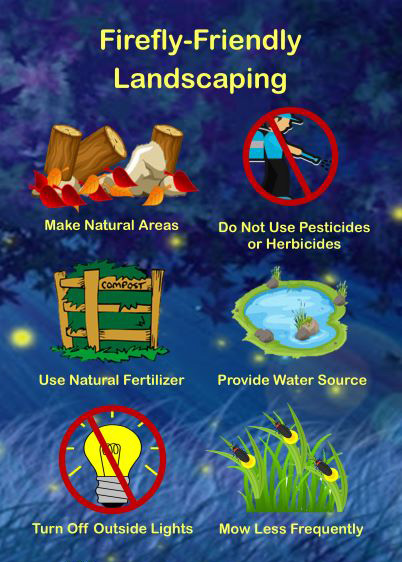By Kim Strader
Lightning bugs, fireflies, or glow bugs – regardless of what you called them, many of us have fond childhood memories of seeing their blinking lights at night in the summer. I remember feeling as if they were stars that came down out of the sky so that I could catch them and make a wish. I spent many summer evenings catching lightning bugs with my grandparents, putting them in a jar (with holes in the lid), and setting them on the bedside table. I would drift off to sleep with my little “stars” gently blinking. The next morning, I would let them go in the grass beside the porch, saying “Have a good day sleeping! I will see you tonight!”
 Now-a-days there seem to be far fewer lightning bugs than when I was 10 years old. Fireflies are, in fact, disappearing and no one knows exactly why. Scientists have only just begun to study fireflies, but there is evidence that we can help their populations by following a few simple steps.
Now-a-days there seem to be far fewer lightning bugs than when I was 10 years old. Fireflies are, in fact, disappearing and no one knows exactly why. Scientists have only just begun to study fireflies, but there is evidence that we can help their populations by following a few simple steps.
- Make natural areas in your yard. The larvae of fireflies live in fallen leaves and rotten logs where they easily find a meal of slugs, snails, and worms. You can help by incorporating dead logs into your landscape as decorative features and using fallen leaves as mulch. Another idea is to set aside an area in your landscape that can remain “messy” and plant a row of native shrubs to visually block the area if you (or your neighbors!) do not like seeing it.
- Do not use pesticides or herbicides in your yard. These chemicals applied to the lawn to kill insects and/or weeds greatly impact fireflies and their larvae. They either come in direct contact with the chemical or encounter it indirectly by eating something that was sprayed.
- Use natural fertilizer. Many chemical fertilizers contain the same harmful compounds as pesticides and greatly impact firefly populations. If you fertilize your landscape, use compost or a commercially available product that is all natural and nontoxic.
- Mow the grass less frequently. Adult fireflies spend daylight hours on the ground among tall grasses. Mow less frequently during firefly season so that you are not disturbing their daytime location. By adding native sedges and grasses to the landscape, you can provide the taller grass-like vegetation preferred by adult fireflies without needing to mow. Another idea is to consider letting the lawn grow taller in a corner of your landscape and planting a row of native shrubs to hide it.
- Provide a water feature. Fireflies love to congregate near standing water or marshy areas. You can help by building a small pond or making a shallow depression filled with water. Empty and replace standing water every 72 hours to avoid breeding mosquitoes.
- Turn off outside lights. Preliminary research reveals that outdoor lighting may disrupt firefly flashing signals to attract mates and warn of danger. Turn off all outdoor lights at night and use blinds over your windows to block indoor lights from shining outdoors.
- Share this information. Educate your friends, family, and neighbors about how they can help fireflies survive and thrive.
Still to this day, I fondly remember those summer nights with my grandparents every time I see a lightning bug flash. Now-a-days, I also can’t help but wonder if there will always be lightning bugs blinking in the summer night-time sky. If we all incorporate these few simple things into our landscapes, we will help keep the fireflies blinking for generations to come so that your grandkids’ kids can drift off to sleep with all their firefly wishes gently blinking.
References:
Firefly Watch Citizen Science Project
Firefly Conservation and Research
Plant NOVA Natives for information on Virginia native grasses, sedges, and shrubs
Composting Basics from the Loudoun County Master Gardeners

